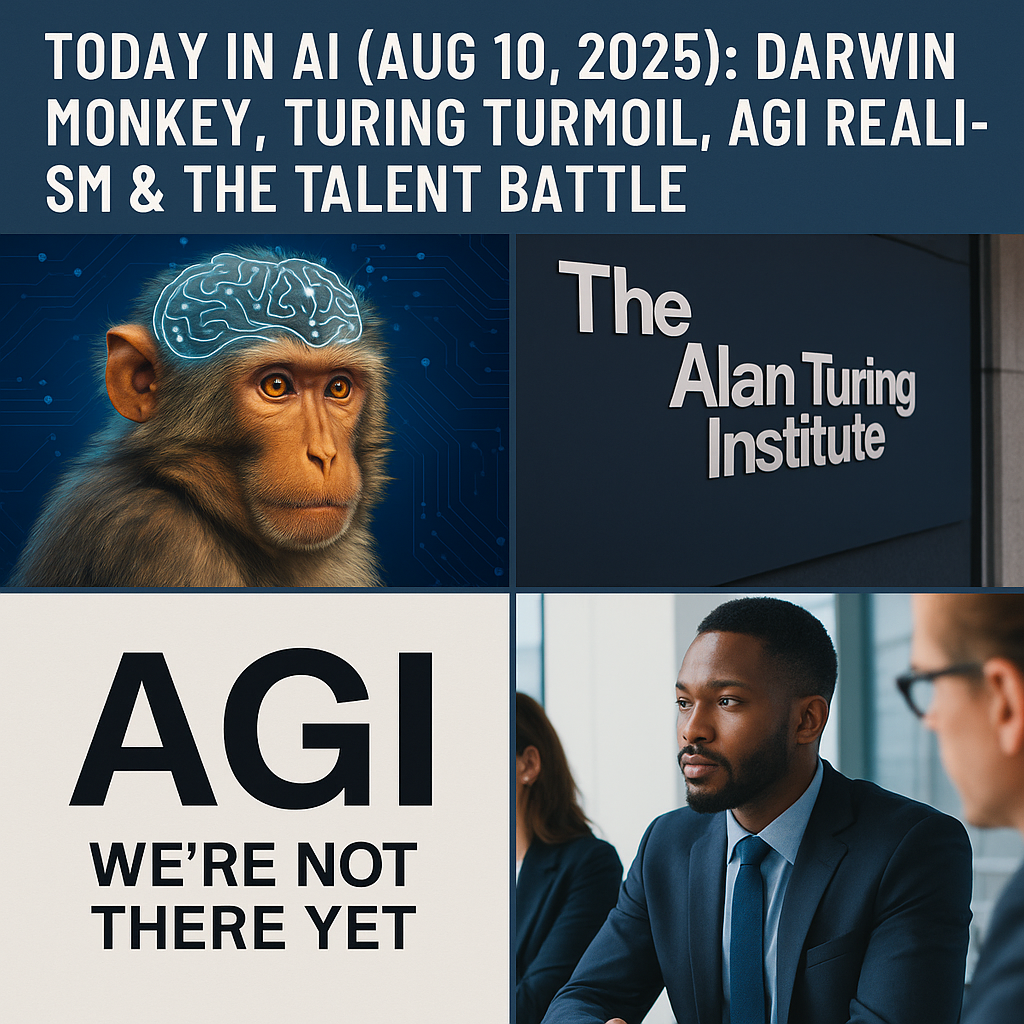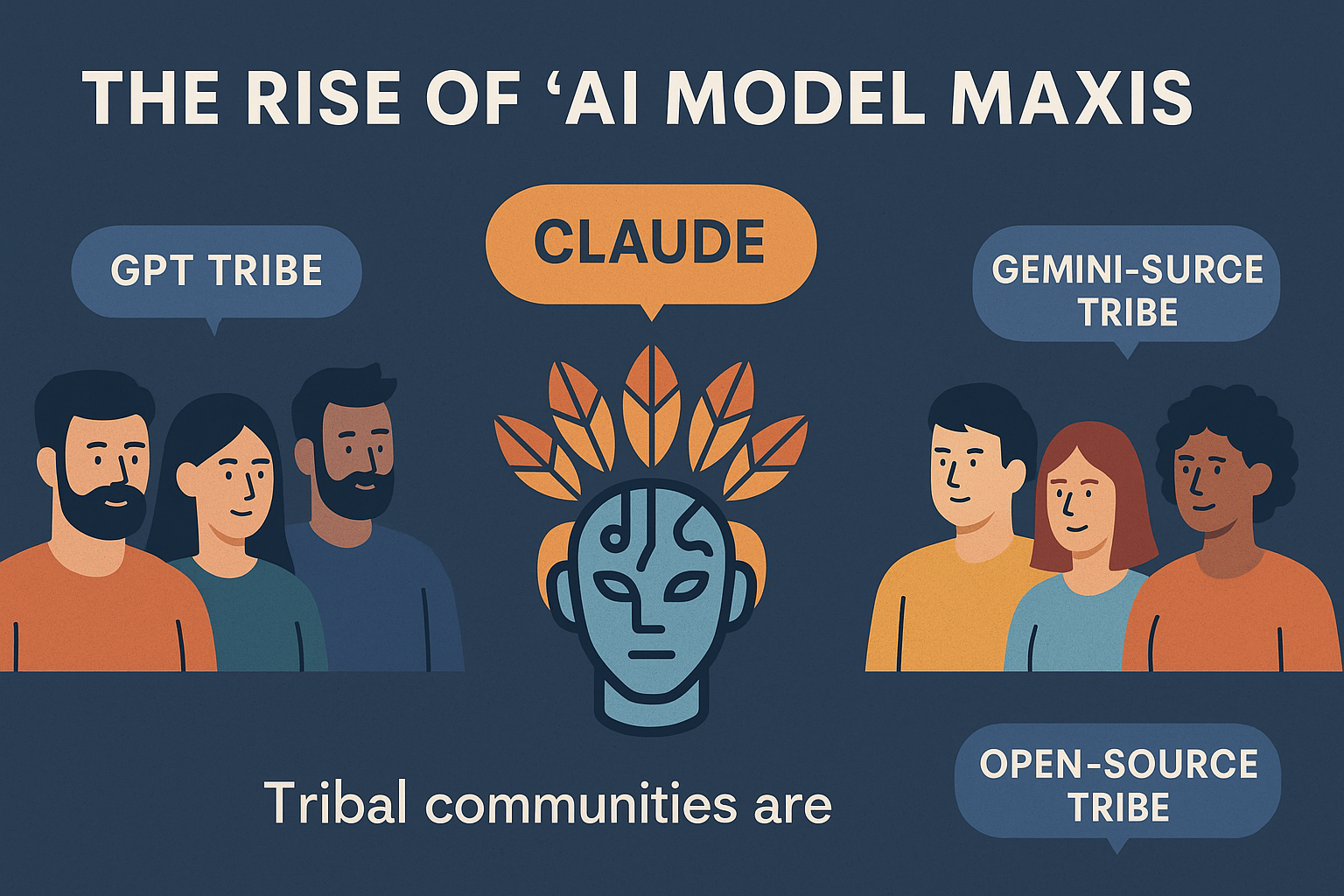Today in AI: Darwin Monkey, Turing Institute Turmoil, AGI Reality Check, and the Talent Wars
Category: AI News & Trends — A 100% human-written, in-depth roundup for busy builders and decision-makers.
If you follow AI even casually, the past 24 hours have been a lot. A brain-inspired system dubbed “Darwin Monkey” made headlines in China, the UK’s flagship AI institute faced a whistleblowing complaint, commentators rekindled the “Are we at AGI?” debate, and the race for top researchers grew more intense as leading labs dangled extraordinary retention packages. Below is a clear, bias-checked briefing on each story — plus why it matters for product teams, researchers, and policy leaders.
1) Darwin Monkey: A Brain-Inspired System That Could Reshape How AI Learns
Chinese researchers introduced a system nicknamed Darwin Monkey, designed to emulate aspects of biological learning at a scale that approaches a macaque brain. Reports describe billions of neuron-like units arranged to study how structure and learning rules influence intelligence, rather than merely throwing more data and compute at the problem. Early coverage suggests the project’s goal is not just performance on benchmarks, but understanding how neural organization yields general problem-solving capacity.
Why this resonates: Modern deep learning has proven incredibly effective, yet it still struggles with sample efficiency, transfer, and robustness outside narrow distributions. Brain-inspired systems point toward architectures that may learn more like humans and animals — leveraging priors, inductive biases, self-supervised objectives, and continual adaptation. If Darwin Monkey delivers credible evidence that structural choices (not just size) produce generality, we could see a wave of research that blends neuroscience and AI engineering far more deeply than today.
Practical takeaway: For teams building next-gen agents or robotics, keep an eye on brain-inspired training curricula and hierarchical control. Even if you never reproduce the exact architecture, the ideas (structured memory, neuromodulation-like signals, curriculum learning) often transfer to production systems. Coverage.
2) Whistleblowing at the Alan Turing Institute: Governance, Culture, and Public Trust
The UK’s Alan Turing Institute, long regarded as a central hub for AI research and policy, is under scrutiny after a whistleblowing complaint was reportedly filed with the Charity Commission. The complaint raises concerns about internal culture, governance, and restructuring that may have affected programs across ethics, public services, and other impact areas.
Why this matters: Institutes like the Turing bridge academia, government, and industry. Their health and credibility influence how national AI strategies are shaped, how grants are allocated, and which topics receive attention (safety, transparency, public-interest applications). Lapses in governance — even if ultimately resolved — can slow projects that citizens rely on, and they can erode trust at a time when public institutions are expected to lead on responsible AI.
Practical takeaway: If you collaborate with public institutes, diversify partnerships and timelines. Build redundancy into grant-funded roadmaps and prepare to communicate clearly with stakeholders when institutional turbulence arises. Report.
3) The AGI Reality Check: “It’s Missing Something”
With multimodal models rapidly improving, commentary this weekend revisited a hard question: How close are we to AGI? Some analysts argue that, despite stunning capabilities, today’s systems still lack elements like persistent self-directed learning, grounded world models, and reliable long-horizon planning. The takeaway is not pessimism — it is precision. Hype dilutes real progress and sets teams up for disappointment when tools fail on edge cases that humans handle with ease.
Why this matters: Product leaders who scope features around hand-wavy “AGI” expectations risk overpromising. Investors and policymakers also need sober assessments to set timelines, evaluation criteria, and safety requirements. The best builders are both bullish and specific: they map tasks to capabilities models actually have, then add retrieval, memory, tools, and guardrails to close gaps.
Practical takeaway: Treat frontier models as powerful components, not complete agents. Instrument them with observability (latency, failure modes, hallucination rates), and design workflows that escalate to humans or smaller specialized models as needed. Analysis.
4) Talent Wars: Retention Packages Reach Eye-Watering Levels
As frontier labs compete, reports indicate that one major player is offering multi-million-dollar bonuses to keep top researchers from jumping ship. This continues a trend that accelerated in 2023–2024 and shows no sign of slowing in 2025. Meanwhile, coverage highlights another lab’s unusually high retention rate, underscoring that culture, not just compensation, can anchor talent.
Why this matters: For the broader ecosystem — startups, SMEs, and applied AI teams — the result is a supply squeeze. Senior researchers and seasoned ML platform engineers are scarce and expensive. But there’s opportunity too: as frontier labs concentrate on long-term bets, practical application teams can win by shipping trustworthy, cost-efficient solutions into neglected enterprise niches.
Practical takeaway: If you can’t outbid, out-design. Offer flexible research time, publish-friendly policies, and a clear mission. Invest in training pipelines for strong software engineers to transition into applied ML. Retention bonuses · Retention culture.
5) Why These Threads Connect
It’s tempting to treat these items as separate. They’re not. Brain-inspired architectures speak to the science of intelligence; institutional turbulence tests the governance we need around that science; the AGI debate shapes the narrative that unlocks (or misallocates) capital; and the talent wars determine who can execute at the edge. Together they explain why AI remains both exhilarating and difficult to steer: the technology is racing ahead while the social, organizational, and economic systems around it struggle to keep pace.
Building With GPT-5
If you’re building with GPT-5 and need scalable content output, pair it with a specialized writing suite to cover marketing and SEO at speed. One option many teams use is Turn Photos Into Talking & Singing Videos — Turn Text & Images Into AI Videos for long-form blogs, ads, and product copy.
Join the Turn Photos Into Talking & Singing Videos — Turn Text & Images Into AI Videos.
Implications by Role
- Developers & product teams: Expect architecture shifts (hybrid symbolic-neural, brain-inspired modules). Design for modularity so you can swap components without rewriting your stack.
- Researchers: Document experimental setups rigorously and share negative results. The field needs signal over spectacle.
- Leaders & PMs: Budget for evaluation and red-team time. Treat safety, provenance, and observability as features — not compliance chores.
- Policy & public sector: Invest in institutional resilience and transparent governance to keep public trust during rapid change.
Quick Reference Table
| Story | What Happened | Why It Matters | Action for Teams |
|---|---|---|---|
| Darwin Monkey | Brain-inspired system with macaque-scale architecture reported | Signals shift from brute-force scaling to structural learning | Track research; prototype curriculum & structured memory |
| Turing Institute complaint | Whistleblowing filed over governance and internal culture | Public trust and project continuity at stake | Diversify partners; adjust grant timelines |
| AGI debate | Commentators argue current systems still “missing something” | Prevents over-promising; refocus on measurable progress | Instrument models; add tools, memory, and human review |
| Talent retention | Multi-million bonuses; standout retention at rivals | Supply squeeze for senior researchers continues | Compete with mission, flexibility, and growth ladders |
Editorial View: Measured Ambition Wins
The lesson across today’s stories is not to slow down — it’s to stabilize how we move fast. Ambitious roadmaps need disciplined evaluation; breakthrough research needs transparent institutions; talent strategies should elevate people, not just pay them. Teams that balance speed with structure will outlast the hype cycles and ship systems that genuinely help people.
Sources & Further Reading
- China’s “Darwin Monkey” could change how AI learns (Times of India)
- Staff at UK’s top AI institute complain to watchdog (The Guardian)
- “It’s missing something”: AGI, superintelligence, and a race for the future (The Guardian)
- OpenAI offers multi-million-dollar bonuses to retain top AI talent (Moneycontrol)
- AI giant with highest staff retention isn’t Google or Meta (TechRepublic)




